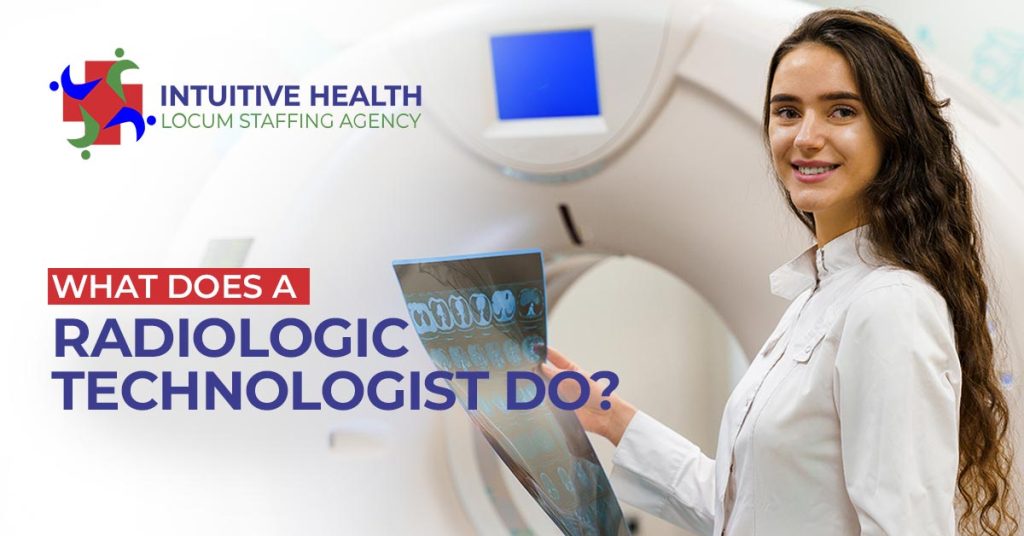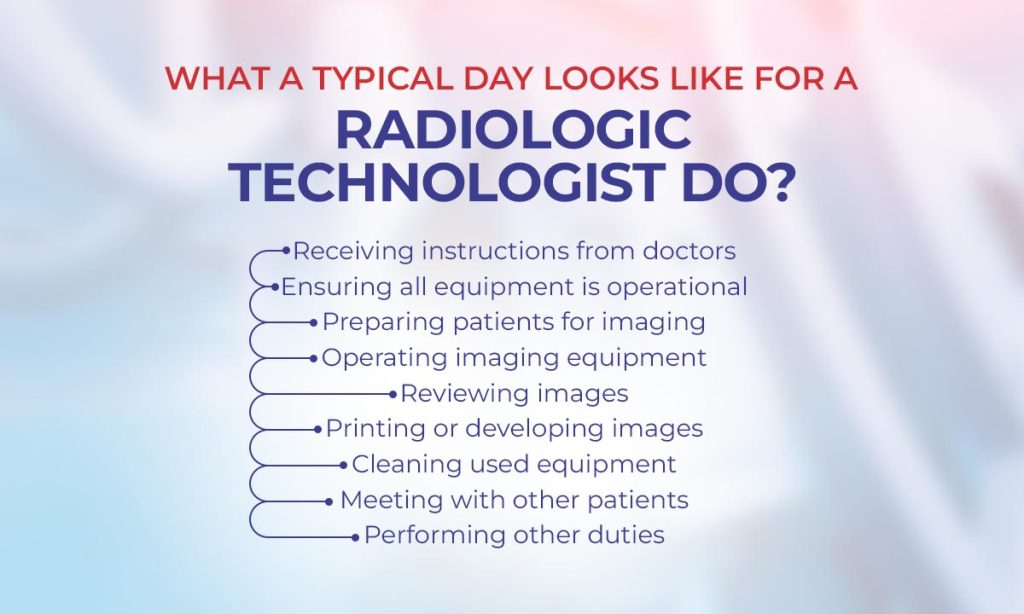Radiologic technologists are the imaging experts behind every clear diagnosis. They operate X-ray, MRI, and CT machines to capture images that help doctors detect broken bones, infections, and even tumors.
Their job isn’t just about running machines. They guide patients, explain procedures, and ensure safety throughout the process. They also follow strict rules on radiation use to protect everyone involved.
Radiologic technologists work closely with doctors and nurses. Their images help form fast, accurate diagnoses. This support can speed up treatment and improve patient outcomes. Their skill in imaging and patient care makes them key to modern medicine.

Radiologic technologists perform X-rays, MRIs, and CT scans to aid diagnosis. Learn their role, skills, and career growth in this essential healthcare field.
So what exactly do they do day to day? Their role goes way beyond “taking pictures.” Let’s look at their daily tasks, top skills, and career growth.
What Is a Radiologic Technologist?
A radiologic technologist is a healthcare worker who takes medical images. These images help doctors find and treat health problems.
They use machines like X-rays, CT scanners, and MRIs. Each tool gives a clear view of bones, organs, or tissues inside the body. These techs are trained to keep patients safe. They follow rules that limit radiation and make sure patients stay comfortable.
Radiologic technologists work as part of a team. They often help doctors called radiologists, who read the images and give reports. This job is important as without clear images, it’s hard for doctors to know what’s wrong or how to treat it. The images taken by these techs guide treatment decisions and help detect everything from fractures to life-threatening diseases.
Types of Imaging and Radiologic Technologist Specialties
Radiologic technologists work in many areas of medical imaging. Each specialty uses different tools and requires special training and certifications.
X-ray (Radiography): This is the most common type of imaging. X-rays help create clear pictures of bones and organs. Doctors use them to find broken bones, infections, and tumors.
Computed Tomography (CT): CT scans take many X-ray images from different angles. A computer puts them together to make detailed cross-section views. CT is useful for checking the chest, belly, and pelvis.
Magnetic Resonance Imaging (MRI): MRI uses magnets and radio waves to take sharp images of soft tissues. It’s great for looking at the brain, spine, joints, and organs. It’s also safe because it uses no radiation.
Mammography: Mammography is used to examine breast tissue. It helps detect breast cancer early. Techs in this field get extra training to take accurate and detailed images.
Sonography (Ultrasound): Ultrasound uses sound waves to capture live images of the body. It’s common in pregnancy care but also checks the heart, abdomen, and blood flow. It’s safe, fast, and doesn’t use radiation.
Nuclear Medicine: This type uses small doses of radioactive materials. Technologists give these to patients to study organs and detect disease. It can also be used to treat certain conditions.
Interventional Radiology: This field uses imaging to help guide small, targeted procedures. Doctors can perform surgery with tiny tools instead of large cuts. This helps patients heal faster and with less pain.
Advanced Roles for Radiologic Technologists: With more experience and extra training, radiologic technologists can move into higher-level roles. These positions offer more responsibility and leadership.
Radiology Supervisor: Leads the imaging team and manages day-to-day tasks. This role involves scheduling staff, maintaining equipment, and ensuring quality care.
Radiologic Technology Educator: Trains future technologists in schools or hospitals. Educators teach imaging techniques, safety, and patient care skills.
PACS Administrator: Oversees digital systems used to store and view medical images. This role keeps the system running smoothly and supports staff using it.
Advanced Practice Radiologic Technologist: Performs complex scans and helps with image-guided procedures. May work closely with doctors during treatments or surgeries.
The Importance of Radiologic Technologists in Health Care
Radiologic technologists play a vital role in today’s medical world. Their work provides clear images that help doctors make accurate diagnoses and plan treatments. These images are often the first step in figuring out what’s wrong with a patient. They play a crucial role in the precise diagnosis of diseases. For example, according to a study, Digital Breast Tomosynthesis (DBT) demonstrated a sensitivity of 87.4% and a specificity of 92.2%, showcasing its accuracy in identifying both the presence and absence of breast cancer.
Radiologic Technologists follow strict safety rules, especially around radiation, to protect both patients and staff. Their skill ensures images are clear, safe, and helpful. They also work closely with doctors, nurses, and other care teams. This teamwork helps improve patient results and makes the care process faster and more efficient.
Radiologic Technologist Education Requirements
To become a radiologic technologist, you need to complete an accredited program. Most students earn an associate degree. These programs include both classwork and hands-on training in a clinic.
You’ll study anatomy, how to care for patients, radiation safety, and how to use imaging machines. This mix of learning helps prepare you for real-life work in hospitals or clinics.
License & Certifications
To work in most states, you’ll need a license. Each state has its own rules, but most require you to finish an approved program and pass a test. The most recognized test comes from the American Registry of Radiologic Technologists (ARRT). Passing it earns you a certification that many employers look for.
You can also get certified in special areas like:
- CT (Computed Tomography)
- MRI (Magnetic Resonance Imaging)
- Mammography
These extra certifications can boost your career and show you’re skilled in specific imaging methods. However, to keep your certification, you’ll need to continue learning. This ongoing education helps you stay up to date with new tools and best practices in the field.
What Does a Radiologic Technologist Do Every Day?
Radiologic technologists have active, hands-on roles in healthcare. Their daily tasks are a mix of patient care, technical work, and teamwork. Here’s what a typical day includes:

Patient Preparation: They greet patients, explain the procedure, and answer any questions. They also make sure each patient is in the right position before starting the scan.
Image Evaluation: They check the images for quality and clarity. If an image isn’t clear, they retake it to make sure nothing is missed.
Safety Measures: They follow safety rules to limit exposure to radiation—for both the patient and themselves.
Record Maintenance: They update patient records and document each procedure clearly and correctly.
Collaboration: They work with radiologists and other healthcare staff. Together, they use the images to help diagnose and plan care.
Equipment Maintenance: They clean and check machines often to make sure everything works well and stays safe.
Radiologic Technologist Skills
Radiologic technologists need a wide range of skills to do their jobs well. These skills help them take clear images and care for patients safely and kindly:
Technical Proficiency: They must know how to use complex imaging machines. They adjust settings to fit each scan and make sure everything runs smoothly.
Communication Skills: They must explain procedures clearly, answer questions, and ease patient fears. Good communication also helps them work well with doctors and nurses.
Critical Thinking: They need to think quickly and respond to changing situations. This helps them get the best images while keeping patients safe.
Problem-Solving: If a machine isn’t working right or a scan is tricky, they must adjust quickly to get the right results.
Time Management: They often care for many patients in a shift. Managing time well keeps everything running on schedule.
Knowledge of Safety Protocols: They follow rules to protect patients and staff from too much radiation. Safety is always a top priority.
Physical Stamina: The job can be active. Technologists stand for long periods and help move or position patients as needed.
Radiologic Technologist Work Environment
Radiologic technologists work in many healthcare settings. These include hospitals, outpatient clinics, and imaging centers. Most of their day is spent on their feet—helping patients and using imaging machines.
The work is fast-paced and often physical. Technologists must stay alert and focused, especially when moving equipment or positioning patients. Safety is a big part of the job. They follow strict rules to limit radiation exposure for both patients and themselves. Wearing protective gear and using shielding tools is part of their routine.
They also work closely with radiologists, doctors, and nurses. Teamwork helps make sure the images they capture are clear and useful for diagnosis and treatment. Depending on the workplace, hours can vary. Some technologists work evenings, weekends, or stay on-call to handle emergencies.
Steps to Become a Radiologic Technologist
Thinking about a career as a radiologic technologist? Here’s how to get started, step by step:
- Get Your High School Diploma: Start with a strong foundation. Focus on science and math classes like biology, physics, and algebra.
- Complete an Accredited Program: Join a radiologic technology program that includes both classroom learning and hands-on clinical training. Most programs lead to an associate degree.
- Pass the Certification Exam: Take and pass the ARRT (American Registry of Radiologic Technologists) exam. This certification is a key step in proving your skills and knowledge.
- Get Licensed in Your State: Each state has its own licensing rules. Be sure to meet your state’s specific requirements and submit the needed forms.
- Gain Real-World Experience: Work under supervision to build your confidence and skill. Clinical practice helps you apply what you’ve learned in real settings.
- Choose a Specialty (Optional): Want to go further? You can train in specific areas like MRI, CT, or mammography to expand your career options.
- Keep Learning: To keep your certification active, complete continuing education. This helps you stay updated with new tools and best practices.
Radiologic technologists are key players in patient care. They take images that help doctors find and treat health issues. Their precision and focus help improve outcomes and build trust in the care process.
Get Access to Top Talent with the Best Healthcare Staffing Agency
And as the need for skilled healthcare workers grows, hiring the right talent matters more than ever. That’s where Intuitive Health Services can help. We provide medical staffing solutions that connect hospitals and clinics with experienced radiologic technologists and other medical professionals. With our help, healthcare teams get the right people, so they can give patients the best care possible.
Connect with Intuitive Health Services and get access to top medical professionals.
Contact Now.
FAQs
- What is the job outlook for radiologic technologists?
The demand for radiologic technologists is rising. With an aging population and growing reliance on medical imaging, job opportunities are expected to increase. - How long does it take to become a radiologic technologist?
Most programs take about two years to complete an associate degree. Specializing in advanced imaging may require additional training. - Do radiologic technologists work directly with patients?
Yes, they interact with patients every day. They explain procedures, answer questions, and ensure comfort during imaging exams. - Is becoming a radiologic technologist challenging?
The training requires dedication, but it’s an achievable career with the right effort. Hands-on experience and coursework help students succeed. - What is the difference between a radiologic technologist and a radiologist?
A radiologic technologist operates imaging equipment, while a radiologist is a doctor who interprets the images to diagnose conditions. - Are there opportunities for career growth?
Yes, experienced technologists can earn advanced certifications, move into leadership roles, or teach in the field.

